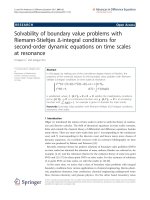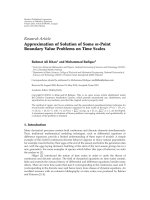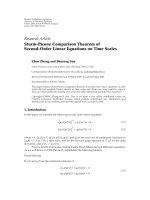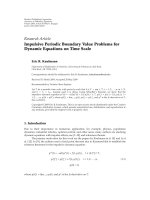EXPONENTIAL STABILITY OF DYNAMIC EQUATIONS ON TIME SCALES ALLAN C. PETERSON AND YOUSSEF N. RAFFOUL pdf
Bạn đang xem bản rút gọn của tài liệu. Xem và tải ngay bản đầy đủ của tài liệu tại đây (538.06 KB, 12 trang )
EXPONENTIAL STABILITY OF DYNAMIC EQUATIONS
ON TIME SCALES
ALLAN C. PETERSON AND YOUSSEF N. RAFFOUL
Received 6 July 2004 and in revised form 16 December 2004
We investigate the exponential stability of the zero solution to a system of dynamic equa-
tions on time scales. We do this by defining appropriate Lyapunov-type functions and
then formulate certain inequalities on these functions. Several examples are given.
1. Introduction
This paper considers the exponential stability of the zero solution of the first-order vector
dynamic equation
x
∆
= f (t,x), t ≥ 0. (1.1)
Throughout the paper, we let x(t,t
0
,x
0
) denote a solution of the initial value problem
(IVP) (1.1),
x
t
0
=
x
0
, t
0
≥ 0, x
0
∈ R. (1.2)
(For the existence, uniqueness, and extendability of solutions of IVPs for (1.1)-(1.2), see
[2, Chapter 8].) Also we assume that f :[0,∞) ×R
n
→ R
n
is a continuous function and t
is from a so-called “time scale” T (which is a nonempty closed subset of R). Throughout
the paper, we assume that 0 ∈ T (for convenience) and that f (t,0) = 0, for all t in the time
scale interval [0,∞):={t ∈ T :0≤ t<∞}, and call the zero function the trivial solution
of (1.1).
If T
=
R,thenx
∆
= x
and (1.1)-(1.2) becomes the following IVP for ordinary differ-
ential equations
x
= f (t,x), t ≥ 0, (1.3)
x
t
0
=
x
0
, t
0
≥ 0. (1.4)
Recently, Peterson and Tisdell [7] used Lyapunov-type functions to formulate some suf-
ficient conditions that ensure all solutions to (1.1)-(1.2)arebounded.Earlier,Raffoul [8]
used some similar ideas to obtain boundedness of all solutions of (1.3)and(1.4). Here
Copyright © 2005 Hindawi Publishing Corporation
Advances in Difference Equations 2005:2 (2005) 133–144
DOI: 10.1155/ADE.2005.133
134 Exponential stability of dynamic equations on time scales
we use Lyapunov-type functions on time scales and then formulate appropriate inequal-
ities on these functions that guarantee that the trivial solution to (1.1) is exponentially or
uniformly exponentially stable on [0,∞). Some of our results are new even for the special
cases T =R and T = Z.
To understand the notation used above and the idea of time scales, some preliminary
definitions are needed.
Definit ion 1.1. A time scale T is a nonempty closed subset of the real numbers R.
Since we are interested in the asymptotic behavior of solutions near ∞, we assume that
T is unbounded above.
Since a time scale may or may not be connected, the concept of the jump operator is
useful.
Definit ion 1.2. Define the forward jump operator σ(t)att by
σ(t) =inf{τ>t: τ ∈ T}, ∀t ∈T, (1.5)
and define the graininess function µ :
T →[0,∞)asµ(t) =σ(t) −t.
Also let x
σ
(t) =x(σ(t)), that is, x
σ
is the composite function x ◦σ.Thejumpoperator
σ then allows the classification of points in a time scale in the following way. If σ(t) >t,
then we say that the point t is right scattered; while if σ(t) = t then, we say the point t is
right dense.
Throughout this work, the assumption is made that T has the topology that it inherits
from the standard topology on the real numbers R.
Definit ion 1.3. Fix t ∈T and let x : T → R
n
.Definex
∆
(t) to be the vector (if it exists) with
the property that given > 0, there is a neighborhood U of t with
x
i
σ(t)
−x
i
(s)
−x
∆
i
(t)
σ(t) −s
≤
σ(t) −s
, ∀s ∈ U and each i = 1, ,n.
(1.6)
It is said that x
∆
(t)isthe(delta) derivative of x(t) and that x is (delta) differentiable at t.
Definit ion 1.4. If G
∆
(t) =g(t), t ∈ T, then it is said that G is a (delta) antiderivative of g
and the Cauchy (delta) integral is defined by
t
a
g(s)∆s = G(t) −G(a). (1.7)
For a more general definition of the delta integral, see [2, 3].
The following theorem is due to Hilger [5].
Theorem 1.5. Assume that g :
T →R
n
and let t ∈ T.
(i) If g is differentiable at t, then g is continuous at t.
(ii) If g is continuous at t and t is right scattered, then g is differentiable at t with
g
∆
(t) =
g
σ(t)
−g(t)
σ(t) −t
. (1.8)
A. C. Peterson and Y. N. Raffoul 135
(iii) If g is differentiable and t is right dense, then
g
∆
(t) =lim
s→t
g(t) −g(s)
t −s
. (1.9)
(iv) If g is differentiable at t, then g(σ(t)) =g(t)+µ(t)g
∆
(t).
We assume throughout that t
0
≥ 0andt
0
∈ T. By the time scale interval [t
0
,∞), we
mean the set {t ∈ T : t
0
≤ t<∞}. The theory of time scales dates back to Hilger [5]. The
monographs [2, 3, 6] a lso provide an excellent introduction.
2. Lyapunov functions
In this section, we define what Peterson and Tisdell [7] call a type I Lyapunov function
and summarize a few of the results and examples given in [7]relativetowhatwedohere.
Definit ion 2.1. It is said that V : R
n
→ R
+
is a “type I” Lyapunov function on R
n
provided
that
V(x) =
n
i=1
V
i
x
i
= V
1
x
1
+ ···+ V
n
x
n
, (2.1)
where each V
i
: R
+
→ R
+
is continuously differentiable and V
i
(0) =0.
Peterson and Tisdell [7]provedthatifV is a type I Lyapunov function and the function
˙
V is defined by
˙
V(t,x) =
1
0
∇V
x + hµ(t)
· f (t,x)dh, (2.2)
where ∇=(∂/∂x
1
, ,∂/∂x
n
) is the gradient operator and the “·” denotes the usual scalar
product, then, if x is a solution to (1.1), it follows that
V
x(t)
∆
=
˙
V
t,x(t)
. (2.3)
Peterson and Tisdell [7] also show that
˙
V(t,x) =
n
i=1
V
i
x
i
+ µ(t) f
i
(t,x)
−V
i
x
i
µ(t)
when µ(t) =0,
∇V(x) · f (t,x)whenµ(t) =0.
(2.4)
Sometimes the domain of V will be a subset D of R
n
.
Note that V = V(x) and even if the vector field associated with the dynamic equation
is autonomous,
˙
V still depends on t (and x of course) when the graininess function of
T is nonconstant. Several formulas are given in Peterson and Tisdell [7]for
˙
V(t,x)for
various type I Lyapunov functions V(x). In this paper, the only one of these formulas
that we will use is that if V(x) =x
2
,then
˙
V(t,x)
= 2x · f (t,x)+µ(t)
f (t,x)
2
. (2.5)
136 Exponential stability of dynamic equations on time scales
It is the second t erm in (2.5) that usually makes the Lyapunov theory for time scales much
more difficult than the continuous case.
3. Exponential stability
In this section, we present some results on the exponential stability of the trivial solution
of (1.1).Firstwegiveafewmorepreliminaries.
Definit ion 3.1. Assume that g : T → R. Define and denote g ∈ C
rd
(T;R) as right-dense
continuous (rd-continuous) if g is continuous at every right-dense point t ∈ T and
lim
s→t
−
g(s) exists and is finite at every left-dense point t ∈T, where left-dense is defined
in the obvious manner.
If g
∈ C
rd
,theng has a (delta) antiderivative [2, Theorem 1.74]. Now define the so-
called set of regressive functions, by
=
p : T −→ R; p ∈C
rd
(T;R)and1+p(t)µ(t) =0onT
. (3.1)
Under the addition on defined by
(p ⊕q)(t):= p(t)+q(t)+µ(t)p(t)q(t), t ∈T, (3.2)
is an Abelian group (see [2, exercise 2.26]), where the additive inverse of p, denoted by
p,isdefinedby
(p)(t):=
−p(t)
1+µ(t)p(t)
, t ∈T. (3.3)
Then define the set of positively regressive functions by
+
=
p ∈ :1+p(t)µ(t) > 0onT
. (3.4)
For p ∈ , the generalized exponential function e
p
(·,t
0
)onatimescaleT can be
defined (see [2, Theorem 2.35]) to be the unique solution to the IVP
x
∆
= p(t)x, x
t
0
=
x
0
. (3.5)
We will frequently use the fact that if p ∈
+
,then[2, Theorem 2.48] e
p
(t,t
0
) > 0for
t ∈ T. We will use many of the properties of this (generalized) exponential function,
which are summarized in the following theorem (see [2, Theorem 2.36]).
Theorem 3.2. If p, q ∈,thenfort, s, r ∈T,
(i) e
0
(t,s) ≡ 1 and e
p
(t,t) ≡1;
(ii) e
p
(σ(t),s) = (1 +µ(t)p(t))e
p
(t,s);
(iii) 1/e
p
(t,s) = e
p
(t,s);
A. C. Peterson and Y. N. Raffoul 137
(iv) e
p
(t,s) = 1/e
p
(s,t) =e
p
(s,t);
(v) e
p
(t,s)e
p
(s,r) =e
p
(t,r);
(vi) e
p
(t,s)e
q
(t,s) = e
p⊕q
(t,s);
(vii) e
p
(t,s)/e
q
(t,s) = e
pq
(t,s), where p q := p ⊕(q).
It follows from Bernoulli’s inequality (see [2, Theorem 6.2]) that for any time s cale, if
the constant λ ∈
+
,then
0 <e
λ
t,t
0
≤
1
1+λ
t −t
0
, t ≥t
0
. (3.6)
It follows that
lim
t→∞
e
λ
t,t
0
= 0. (3.7)
In particular, if T = R,thene
λ
(t,t
0
) = e
−λ(t−t
0
)
and if T = Z
+
,thene
λ
(t,t
0
) = (1 +
λ)
−(t−t
0
)
. For the growth of generalized exponential functions on time scales, see Bod-
ine and Lutz [1]. With all this in mind, we make the following definition.
Definit ion 3.3. Say that the trivial solution of (1.1)isexponentially stable on [0,∞)ifthere
exist a positive constant d, a constant C ∈ R
+
,andanM>0 such that for any solution
x(t, t
0
,x
0
)oftheIVP(1.1)-(1.2), t
0
≥ 0, x
0
∈ R
n
,
x
t,t
0
,x
0
≤ C
x
0
,t
0
e
M
t,t
0
d
, ∀t ∈
t
0
,∞
, (3.8)
where ·denotes the Euclidean norm on R
n
. The trivial solution of (1.1)issaidtobe
uniformly exponentially stable on [0, ∞)ifC is independent of t
0
.
Note that if T
=
R,then(e
λ
(t,t
0
))
d
= e
−λd(t−t
0
)
and if T
=
Z
+
,then(e
λ
(t,t
0
))
d
=
(1 + λ)
−dλ(t−t
0
)
.
We are now ready t o present some results.
Theorem 3.4. Assume that D ⊂ R
n
contains the origin and there exists a type I Lyapunov
function V : D →[0,∞) such that for all (t,x) ∈[0,∞) ×D,
W
x
≤ V(x) ≤φ
x
, (3.9)
˙
V(t,x)
≤
ψ
x
−L(M δ)(t)e
δ
(t,0)
1+µ(t)M
, (3.10)
ψ
φ
−1
V(x)
+ MV(x) ≤ 0, (3.11)
where W, φ, ψ are continuous functions such that φ,W :[0,∞) → [0,∞), ψ :[0,∞) →
(−∞,0], ψ is nonincreasing, φ and W are strictly increasing; L ≥0, δ>M>0 are constants.
Then all solutions of (1.1)-(1.2)thatstayinD satisfy
x(t)
≤ W
−1
V
x
0
+ L
e
M
t,t
0
, ∀t ≥ t
0
. (3.12)
138 Exponential stability of dynamic equations on time scales
Proof. Let x be a solution to (1.1)-(1.2) that stays in D for all t ≥0. Consider
V
x(t)
e
M
(t,0)
∆
=
˙
V
t,x(t)
e
σ
M
(t,0)+V
x(t)
e
∆
M
(t,0), using (2.3) and the product rule
≤
ψ
x(t
−L(M δ)(t)e
δ
(t,0)
e
M
(t,0)+MV
x(t)
e
M
(t,0), by (3.10)
=
ψ
x(t
−
L(M δ)(t)e
δ
(t,0)+MV
x(t)
e
M
(t,0)
≤
ψ
φ
−1
V
x(t)
+ MV
x(t)
−L(M δ)(t)e
δ
(t,0)
e
M
(t,0), by (3.9)
≤−L(M δ)(t)e
δ
(t,0)e
M
(t,0), by (3.11)
=−L(M δ)(t)e
Mδ
(t,0), by Theorem 3.2.
(3.13)
Integrating both sides from t
0
to t with x
0
= x(t
0
), we obtain, for t ∈[t
0
,∞),
V
x(t)
e
M
(t,0) ≤ V
x
0
e
M
t
0
,0
−Le
Mδ
(t,0)+Le
Mδ
t
0
,0
≤ V
x
0
e
M
t
0
,0
+ Le
Mδ
t
0
,0
≤
V
x
0
+ L
e
M
t
0
,0
.
(3.14)
It follows that for t
∈ [t
0
,∞),
V
x(t)
≤
V
x
0
+ L
e
M
t
0
,0
e
M
(t,0) =
V
x
0
+ L
e
M
t,t
0
. (3.15)
Thus by (3.9),
x(t)
≤ W
−1
V
x
0
+ L
e
M
t,t
0
, t ∈
t
0
,∞
. (3.16)
This concludes the proof.
We now provide a special case of Theorem 3.4 for certain functions φ and ψ.
Theorem 3.5. Assume that D ⊂ R
n
contains the origin and there exists a type I Lyapunov
function V : D →[0,∞) such that for all (t,x) ∈[0,∞) ×D,
λ
1
(t)x
p
≤ V(x) ≤λ
2
(t)x
q
, (3.17)
˙
V(t,x) ≤
−λ
3
(t)x
r
−L(M δ)(t)e
δ
(t,0)
1+Mµ(t)
, (3.18)
V(x) −V
r/q
(x) ≤0, (3.19)
A. C. Peterson and Y. N. Raffoul 139
where λ
1
(t), λ
2
(t),andλ
3
(t) are positive functions, where λ
1
(t) is nondecreasing; p, q, r
are positive constants; L is a nonnegative constant, and δ>M:=inf
t≥0
λ
3
(t)/[λ
2
(t)]
r/q
> 0.
Then the triv ial solution of (1.1) is exponentially stable on [0,∞).
Proof. As in the proof of Theorem 3.4,letx be a solution to (1.1)-(1.2) that stays in D for
all t ≥ 0. Since M = inf
t≥0
λ
3
(t)/[λ
2
(t)]
r/q
> 0, e
M
(t,0) is well defined and positive. Since
λ
3
(t)/[λ
2
(t)]
r/q
≥ M,wehave
V
x(t)
e
M
(t,0)
∆
=
˙
V
t,x(t)
e
σ
M
(t,0)+V
x(t)
e
∆
M
(t,0), using (2.3) and the product rule
≤
−λ
3
(t)
x(t)
r
−L(M δ)(t)e
δ
(t,0)
e
M
(t,0)+MV
x(t)
e
M
(t,0), by (3.18)
≤
−λ
3
(t)
λ
2
(t)
r/q
V
r/q
x(t)
+ MV
x(t)
−L(M δ)(t)e
δ
(t,0)
e
M
(t,0), by (3.17)
≤
M
V(x(t)
−V
r/q
x(t)
−L(M δ)(t)e
δ
(t,0)
e
M
(t,0)
≤−L(M δ)(t)e
Mδ
(t,0), by (3.19).
(3.20)
Integrating both sides from t
0
to t with x
0
= x(t
0
), and by invoking condition (3.17)and
the fact that λ
1
(t) ≥λ
1
(t
0
), we obtain
x(t)
≤ λ
−1/p
1
(t)
V
x
0
+ L
e
M
t,t
0
1/p
(3.21)
≤ λ
−1/p
1
t
0
V
x
0
+ L
e
M
t,t
0
1/p
, ∀t ≥ t
0
. (3.22)
This concludes the proof.
Remark 3.6. In Theorem 3.5,ifλ
i
(t) =λ
i
, i = 1,2,3, are positive constants, then the trivial
solution of (1.1) is uniformly exponentially stable on [0,∞). The proof of this remark
follows from Theorem 3.5 by taking δ>λ
3
/[λ
2
]
r/q
and M = λ
3
/[λ
2
]
r/q
.
The next theorem is an extension of [4, Theorem 2.1].
Theorem 3.7. Assume that D ⊂ R
n
contains the origin and there exists a type I Lyapunov
function V : D →[0,∞) such that for all (t,x) ∈[0,∞) ×D,
λ
1
x
p
≤ V(x), (3.23)
˙
V(t,x) ≤
−λ
3
V(x) −L(ε δ)(t)e
δ
(t,0)
1+εµ(t)
, (3.24)
where λ
1
, λ
3
, p, δ>0, L ≥0 are constants and 0 <ε<min{λ
3
,δ}. Then the trivial solution
of (1.1) is uniformly exponentially stable on [0,∞).
140 Exponential stability of dynamic equations on time scales
Proof. Let x be a solution to (1.1)-(1.2) that stays in D for all t ∈[0,∞). Since ε ∈
+
,
e
ε
(t,0) is well defined and positive. Now consider
V
x(t)
e
ε
(t,0)
∆
=
˙
V
t,x(t)
e
σ
ε
(t,0)+εV
x(t)
e
ε
(t,0)
≤
−λ
3
V
x(t)
−L(ε δ)(t)e
δ
(t,0)
e
ε
(t,0)+εV
x(t)
e
ε
(t,0), by (3.24)
= e
ε
(t,0)
εV
x(t)
−λ
3
V
x(t)
−L(ε δ)(t)e
δ
(t,0)]
≤−e
ε
(t,0)L(ε δ)(t)e
δ
(t,0)
=−L(ε δ)(t)e
εδ
(t,0).
(3.25)
Integrating both sides from t
0
to t,weobtain
V
x(t
e
ε
(t,0) ≤ V
x
0
e
ε
t
0
,0
−Le
εδ
(t,0)+Le
εδ
t
0
,0
≤ V
x
0
e
ε
t
0
,0
+ Le
εδ
t
0
,0
≤
V
x
0
+ L
e
ε
t
0
,0
.
(3.26)
Dividing both sides of the above inequality by e
ε
(t,0), we obtain
V
x(t)
≤
V
x
0
+ L
e
ε
t
0
,0
e
ε
(t,0)
=
V
x
0
+ L
e
ε
t,t
0
.
(3.27)
The proof is completed by invoking condition (3.23).
4. Examples
We now present some examples to illustrate the theory de veloped in Section 3.
Example 4.1. Consider the IVP
x
∆
= ax + bx
1/3
e
δ
(t,0), x
t
0
=
x
0
, (4.1)
where δ>0, a, b are constants, x
0
∈ R,andt
0
∈ [0,∞). If there is a constant 0 <M<δ
such that
2a + a
2
µ(t)+1
1+Mµ(t)
≤−M, (4.2)
2
3
µ(t)b
2
3/2
+
2b +2abµ(t)
3
3
1+Mµ(t)
≤−L(M δ)(t), (4.3)
for some constant L ≥ 0andallt ∈ [0,∞), then the trivial solution of (4.1)isuniformly
exponentially stable.
A. C. Peterson and Y. N. Raffoul 141
Proof. We will show that under the above assumptions, the conditions of Remark 3.6 are
satisfied. Choose D = R and V(x) = x
2
,then(3.17) holds with p = q = 2, λ
1
= λ
2
= 1.
Now from (2.5),
˙
V(t,x)
= 2x · f (t,x)+µ(t)
f (t,x)
2
= 2x
ax + bx
1/3
e
δ
(t,0)
+ µ(t)
ax + bx
1/3
e
δ
(t,0)
2
≤
2a + a
2
µ(t)
x
2
+
2b +2abµ(t)
x
4/3
e
δ
(t,0)+b
2
µ(t)x
2/3
e
δ
(t,0)
2
.
(4.4)
To further simplify the above inequality, we make use of Young’s inequality, which says
that for any two nonnegative real numbers w and z,wehave
wz
≤
w
e
e
+
z
f
f
,with
1
e
+
1
f
= 1, e, f>1. (4.5)
Thus, for e
= 3/2and f = 3, we get
x
4/3
2b +2abµ(t)
e
δ
(t,0) ≤
x
4/3
3/2
3/2
+
2b +2abµ(t)
3
e
δ
(t,0)
3
3
=
2
3
x
2
+
2b +2abµ(t)
3
e
δ
(t,0)
3
3
,
x
2/3
b
2
µ(t)
e
δ
(t,0)
2
≤
x
2/3
3
3
+
b
2
µ(t)
e
δ
(t,0)
2
3/2
3/2
=
x
2
3
+
2
3
µ(t)b
2
3/2
e
δ
(t,0)
3
.
(4.6)
Thus, putting everything together, we arrive at
˙
V(t,x) ≤
2a + µ(t)a
2
+1
x
2
+
2
3
µ(t)b
2
3/2
+
2b +2abµ(t)
3
3
e
δ
(t,0)
3
≤
2a + µ(t)a
2
+1
x
2
+
2
3
µ(t)b
2
3/2
+
2b +2abµ(t)
3
3
e
δ
(t,0).
(4.7)
Dividing and multiplying the right-hand side by (1 + Mµ(t)), we see that (3.18)holds
under the above assumptions with r =2 (note that λ
3
= M). Also, since r =q = 2, (3.19)
is satisfied. Therefore all the hypotheses of Remark 3.6 are satisfied and we conclude that
the trivial solution of (4.1) is uniformly exponentially stable. We next look at the three
special cases of (4.1)when
T
=
R, T
=
N
0
,andT
=
hN
0
={0,h,2h, }.
Case 4.2. If T = R,thenµ(t) = 0 and it is easy to see that if we assume that a<−1/2,
then (4.2)istrueifwetakeM =−(2a +1)> 0. For L = 8|b|
3
/3(δ −M), condition (4.3)
is satisfied. Hence in this case we conclude that if a<−1/2andδ>−(2a + 1), then the
trivial solution to (4.1) is uniformly exponentially stable.
142 Exponential stability of dynamic equations on time scales
Case 4.3. If T = N
0
,thenµ(t) =1 and condition (4.2) cannot be satisfied for positive M.
To get around this, we will adjust the steps leading to inequality (4.7)asfollows:
x
4/3
2b +2abµ(t)
e
δ
(t,0) ≤
2b +2abµ(t)
x
4/3
3/2
3/2
+
e
δ
(t,0)
3
3
=
2
3
2b +2abµ(t)
x
2
+
2b +2abµ(t)
3
e
δ
(t,0)
3
,
x
2/3
b
2
µ(t)
e
δ
(t,0)
2
≤ b
2
µ(t)
(x
2/3
)
3
3
+
e
δ
(t,0)
2
3/2
3/2
=
b
2
µ(t)
x
2
3
+
2
3
µ(t)b
2
e
δ
(t,0)
3
.
(4.8)
Hence, inequality (4.7)becomes
˙
V(t,x) ≤
2a + µ(t)a
2
+
2
3
2b +2abµ(t)
+
µ(t)b
2
3
x
2
+
2b +2abµ(t)
+(2/3)µ(t)b
2
3
e
δ
(t,0).
(4.9)
Now, if T
=
N
0
,thenµ(t) =1 and so from this last inequality, given δ>0, we want to find
0 <M<δand L ≥ 0suchthat
2a + a
2
+
2
3
|2b +2ab|+
b
2
3
(1 + M) ≤−M, (4.10)
|2b +2ab|+(2/3)b
2
3
(1 + M) ≤−L(M δ)(t) =
δ −M
1+δ
L. (4.11)
Note that condition (4.10) is satisfied for all M>0sufficiently small if
2a + a
2
+
2
3
|2b +2ab|+
b
2
3
< 0. (4.12)
For such a 0 <M<δ,ifwetake
L =
2
3|b||1+a|+ b
2
(1 + M)(1 + δ)
9(δ −M)
, (4.13)
then (4.3) is satisfied (note that for each δ>0, we can find such an M so our result holds
for all δ). In conclusion, we have for the case T
=
N
0
that if (4.12) holds, then the t rivial
solution of (4.1) is uniformly exponentialy stable. In particular if a =−4/5andb = 1/5,
then (4.12) is satisfied.
Case 4.4. If T
=
hN
0
={0,h,2h, },thenµ(t) = h and in this case by (4.2)and(4.3), we
want to find 0 <M<δand L ≥ 0suchthat
2a + a
2
h +1
≤
−M
(1 + Mh)
, (4.14)
2b +2abh
3
+(2/3)
hb
2
3/2
3
(1 + hM) ≤−L(M δ)(t) =
δ −M
1+hδ
L. (4.15)
A. C. Peterson and Y. N. Raffoul 143
Note that (4.14) is satisfied for all M>0sufficiently small provided that h>0 satisfies
ha
2
+2a+1< 0. (4.16)
Now the polynomial
p(a):= ha
2
+2a+ 1 (4.17)
will have distinct real roots
a
1
(h) =
−1 −
√
1 −h
h
,
a
2
(h) =
−
1+
√
1 −h
h
(4.18)
if 0 <h<1. Therefore if 0 <h<1anda
1
(h) <a<a
2
(h), then
ha
2
+2a+1< 0 (4.19)
asdesired.Now,forsuchanh,ifwelet
L =
(2/9)
hb
2
3/2
+ |2b +2abh|
3
/3
(1 + Mh)
δ −M
(1 + δh), (4.20)
then (4.15) is satisfied. Putting this all together, we get that if 0 <h<1and
a
1
(h) <a<a
2
(h), (4.21)
then the trivial solution of (4.1) is uniformly exponentially stable.
Remark 4.5. It is interesting to note that
lim
h→0+
a
2
(h) = lim
h→0+
−1+
√
1 −h
h
=
−1
2
,
lim
h→0+
a
1
(h) = lim
h→0+
−1 −
1 −h
h =−∞,
(4.22)
recalling that if T
=
R,thenfor−∞ <a<−1/2, the zero solution to (4.1)isuniformly
exponentially stable.
Acknowledgment
The second author gratefully acknowledges the support of the Summer Research Fellow-
ships at the University of Dayton.
144 Exponential stability of dynamic equations on time scales
References
[1] S. Bodine and D. A. Lutz, Exponential functions on time scales: their asymptotic behavior and
calculation, Dynam. Systems Appl. 12 (2003), no. 1-2, 23–43.
[2] M. Bohner and A. Peterson, Dynamic Equations on Time Scales,Birkh
¨
auser Boston, Mas-
sachusetts, 2001.
[3] M. Bohner and A Peterson (eds.), Advances in Dynamic Equations on Time Scales,Birkh
¨
auser
Boston, Massachusetts, 2003.
[4] T. Caraballo, On the decay rate of solut ions of nonautonomous differential systems,Electron.J.
Differential Equations (2001), no. 5, 1–17.
[5] S. Hilger, Analysis on measure chains—a unified approach to continuous and discrete calculus,
Results Math. 18 (1990), no. 1-2, 18–56.
[6] V. Lakshmikantham, S. Sivasundaram, and B. Kaymakc¸alan, Dynamic Systems on Measure
Chains, Mathematics and Its Applications, vol. 370, Kluwer Academic Publishers, Dor-
drecht, 1996.
[7] A. C. Peterson and C. C. Tisdell, Boundedness and uniqueness of solutions to dynamic equations
on time scales,J.Difference Equ. Appl. 10 (2004), no. 13–15, 1295–1306.
[8] Y. N. Raffoul, Boundedness in nonlinear differential equations, Nonlinear Stud. 10 (2003), no. 4,
343–350.
Allan C. Peterson: Department of Mathematics, College of Ar ts and Sciences, University of
Nebraska–Lincoln, Lincoln, NE 68588-0130, USA
E-mail address:
Youssef N. Raffoul: Department of Mathematics, College of Arts and Sciences, University of Day-
ton, Dayton, OH 45469-2316, USA
E-mail address: youssef.raff









